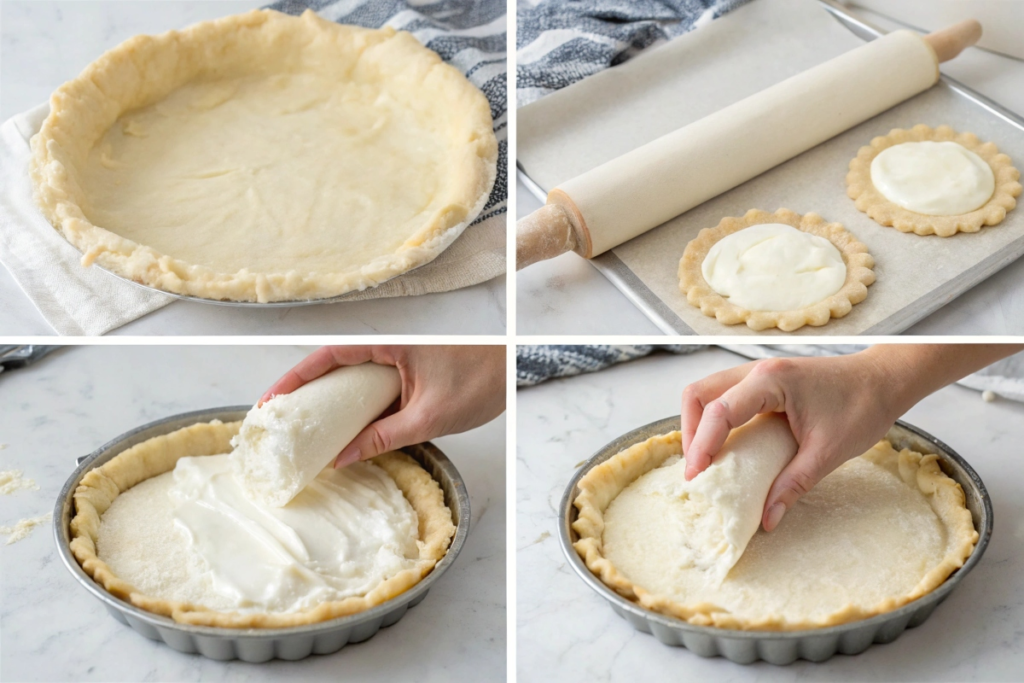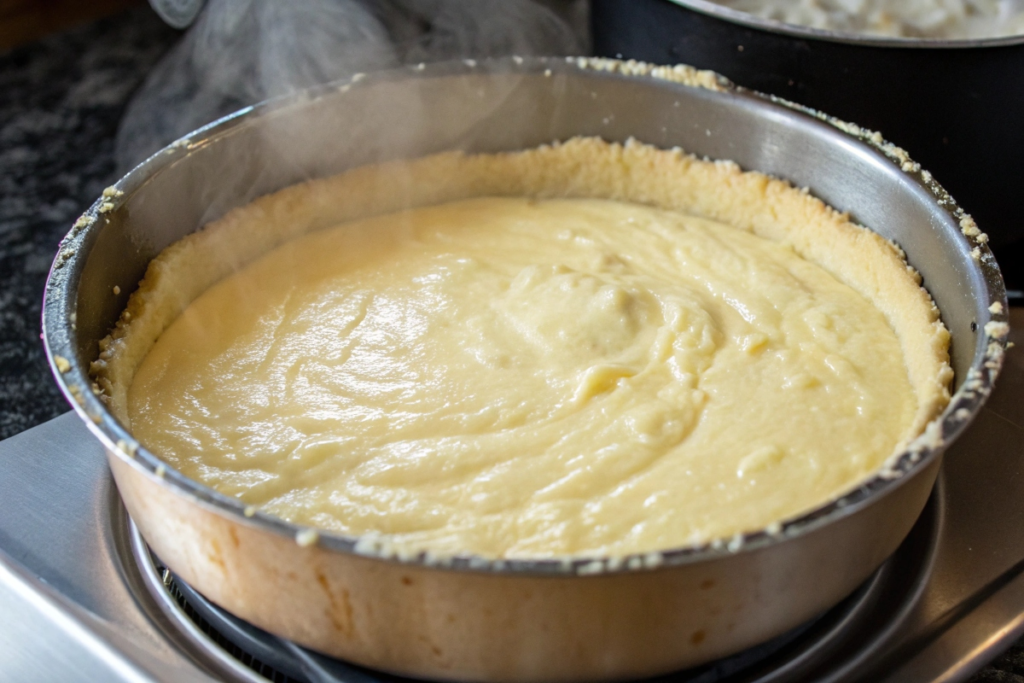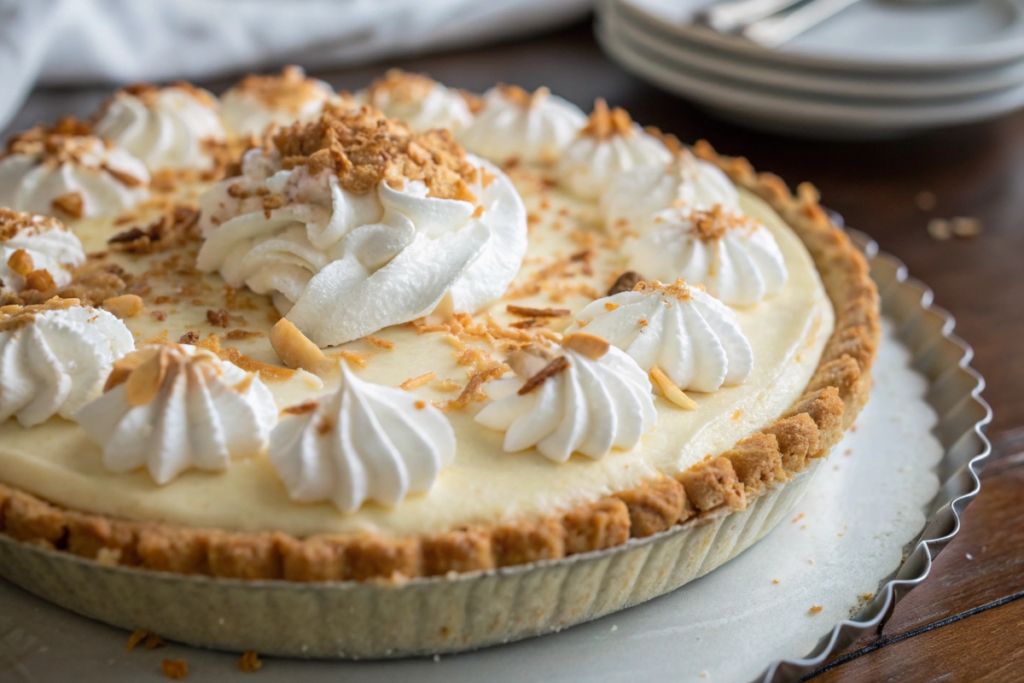Discover time-tested secrets for making an old-fashioned coconut cream pie with a flaky crust and dreamy custard, perfect for every nostalgic sweet tooth.
Table of Contents
Introduction
An old-fashioned coconut cream pie brings sweet memories of family gatherings and cherished holidays. Indeed, its creamy custard and toasted coconut topping offer a timeless flavor that lingers on the palate. Generally, people love this dessert for its comforting taste and relatively simple preparation. Nonetheless, there are hidden tricks and tips that can elevate a homemade coconut cream pie from ordinary to exceptional. Consequently, we will explore its history, essential ingredients, pro techniques, and an easy recipe anyone can follow. Moreover, you will learn how to troubleshoot common issues to ensure your pie always turns out just right.
A Brief History of Coconut Cream Pie

Coconut cream pie has been adored in many parts of the United States for generations. Initially, home bakers discovered the luscious combination of coconut flakes and velvety custard, which quickly stole the spotlight in community cookbooks. Comparatively, its distinct tropical twist set it apart from other custard pies. Because coconut trees do not grow in most U.S. climates, cooks once relied on imported coconut products, making the pie something of a special treat.
Eventually, coconut cream pie became a diner favorite. Many people still recall devouring a slice at vintage lunch counters, topped high with whipped cream. Altogether, the dessert’s consistent popularity reveals how well its rich filling complements a flaky crust. Today, it remains a beloved comfort food across countless American households.
Essential Ingredients and Variations
Old-fashioned coconut cream pie starts with a few key components. However, small tweaks can change the flavor and texture in marvelous ways.
- Coconut: Often, people use shredded sweetened coconut. Another option is unsweetened shredded coconut for a subtler sweetness. Fresh coconut offers a more pronounced flavor, though it can be more labor-intensive to prepare.
- Dairy Choices: Typically, a mixture of whole milk and heavy cream adds body to the custard. Nonetheless, some recipes call for coconut milk for an intensified coconut taste.
- Sweeteners: Granulated sugar is standard, but brown sugar, maple syrup, or honey can supply a unique twist.
- Flavorings: Vanilla extract is the classic choice. Comparatively, a splash of coconut extract or almond extract can enhance the tropical profile.
- Optional Tweaks: Toasted coconut, rum-infused coconut flakes, or even a dark chocolate drizzle on top can add personalized flair.
Accordingly, the best approach is to pick high-quality ingredients. Fresh coconut or premium coconut milk improves the final result, while real vanilla extract deepens the aroma.
Why Old-Fashioned Coconut Cream Pie Keeps Winning Hearts

There are countless pies in the American dessert canon. However, a proper old-fashioned coconut cream pie consistently stands out for several reasons. Chiefly, this dessert delivers a robust coconut flavor in every bite. Equally, the creamy custard balances sweetness with a smooth, luscious texture that melts in your mouth. Meanwhile, the crisp crust offers a welcome contrast to the silken filling.
Furthermore, the nostalgic element cannot be overlooked. Many people tasted this dessert in childhood, forming cherished memories that linger well into adulthood. Consequently, every new slice rekindles feelings of comfort and joy. Undoubtedly, that emotional connection helps keep coconut cream pie in high demand, whether at family reunions or small-town diners. Moreover, the pie’s relative simplicity makes it approachable even for novice bakers.
Important Elements in a Classic Coconut Cream Pie
A classic coconut cream pie recipe usually begins with a pastry crust. Afterward, you pour a cooked custard made of milk, eggs, sugar, and cornstarch over a layer of shredded coconut. Particularly, it must be simmered just enough to form a thick, creamy consistency without scorching the milk. Equally important is a light touch with sweetener. If the filling is too sugary, it can overshadow the subtle nutty taste of coconut.
Eventually, the pie sets in the fridge. Then, it is crowned with whipped cream or meringue and a decorative sprinkle of toasted coconut flakes. Especially in an old-fashioned coconut cream pie, that finishing layer of coconut is essential. It provides the signature crunch and a pleasing toasted aroma. Altogether, this straightforward approach explains why the dessert remains beloved in American homes.
Crafting a Traditional Coconut Cream Pie Crust
A perfect crust is vital. Consequently, the right foundation sets the tone for an extraordinary traditional coconut cream pie. Generally, you can select a flaky pastry crust or a simple cookie crust. Nonetheless, each offers its own charm.
For many, the pastry crust is nonnegotiable. This buttery layer complements the creamy filling, creating a balanced mouthfeel. Basically, you blend flour, salt, and chilled butter before adding a small amount of ice water. After shaping the dough into a disk, let it rest in the refrigerator, allowing the gluten to relax. Thus, the resulting crust will be tender rather than tough.
Perfect Techniques for a Time-Honored Coconut Cream Pie Base
To achieve a time-honored coconut cream pie crust, blind-baking is often recommended. Initially, line the pie shell with parchment paper and fill with pie weights or dried beans. Bake until it turns a pale golden hue. Remove the weights, then continue baking until the crust is fully crisp. Consequently, this method prevents a soggy bottom and readies the pastry to hold up against the moist filling.
Additionally, keep an eye on the crust’s edges. They can overbrown if left unchecked. Therefore, use a pie shield or foil to protect those delicate edges. Eventually, your crust will be evenly baked with a hint of color. Allow it to cool fully before pouring in the warm custard.
Building the Ultimate Vintage Coconut Cream Pie Filling

Once the crust is ready, focus on the heart of any vintage coconut cream pie: the filling. Start by combining sugar, cornstarch, and salt in a saucepan. Then, whisk in milk and heavy cream. Chiefly, constant stirring is critical to prevent scorching or lumps. Over medium heat, stir until the mixture begins to thicken. At that point, pour a small amount of hot cream into whisked egg yolks to temper them. This step is vital to avoid curdling.
Next, return everything to the saucepan. Continue to stir until the custard reaches your desired thickness. Generally, you want a pudding-like consistency. Remove from heat and add shredded coconut, butter, and vanilla extract. In some recipes, you can incorporate coconut extract or a splash of rum for a bit of warmth. Indeed, personalizing the filling is one reason old-fashioned coconut cream pie remains so charming.
Secrets to a Creamy Old-Fashioned Coconut Cream Pie Custard
A creamy old-fashioned coconut cream pie custard depends heavily on technique. Specifically, you must cook the mixture slowly and steadily. If the heat is too high, the custard may scorch on the bottom. Conversely, if the stove is too low, the thickening process will take forever, compromising the texture.
After removing the saucepan from heat, add butter for a luscious finish. Butter enriches the custard and helps maintain a silky mouthfeel. Meanwhile, adding shredded coconut infuses extra flavor and texture into the filling. Particularly, the custard might look slightly thick while hot, but it sets even more as it cools. Transfer it into your baked crust and cover with plastic wrap. Place the wrap directly on the custard surface. Consequently, this prevents an unappealing film from forming. Finally, chill the pie thoroughly before serving.
Additional Tips: Toppings, Presentation, and Flavor Boosters
Your old-fashioned coconut cream pie can be elevated in several ways. Firstly, whipped cream is the standard topping. Nonetheless, a lightly sweetened meringue is another classic choice. If you opt for whipped cream, stiff peaks are best. Be careful not to overwhip, or the cream may become grainy.
Topping the cream with toasted coconut flakes adds an appealing crunch and deeper flavor. To toast flakes, scatter them in a skillet and heat over medium-low. Stir them around until lightly browned, which usually takes just a few minutes. Alternatively, place them on a baking sheet in the oven at 325°F (160°C), but keep a close watch because they can burn quickly.
To enhance the coconut flavor, you can drizzle a little coconut syrup on top. Or, for a tropical twist, sprinkle bits of pineapple or mango. Another possibility is a dusting of ground cinnamon for subtle warmth. Indeed, the possibilities are broad, but they all revolve around celebrating that lovely coconut essence.
Common Troubleshooting Tips
Baking an old-fashioned coconut cream pie can sometimes present challenges, but they are typically easy to fix:
- Runny Filling: This often results from insufficient cooking time or an incorrect ratio of cornstarch to liquid. Therefore, measure carefully and follow cooking instructions precisely.
- Weeping Meringue: If you choose meringue, adding sugar too quickly can lead to watery droplets forming on top. Meanwhile, not spreading the meringue over hot filling can also cause issues.
- Soggy Crust: Be sure to fully blind-bake the crust before adding the custard. Additionally, use a pie shield to avoid overbrowning the edges.
- Cracked Pie: Overbaked custard can form cracks. Pay attention to cooking times and keep your oven temperature consistent.
Furthermore, let your pie set in the refrigerator for at least two to four hours. That waiting period is undeniably one of the most crucial steps in perfecting an old-fashioned coconut cream pie.
Step-by-Step Recipe
Below is a clear procedure for creating a homemade old-fashioned coconut cream pie from start to finish. Follow each step for a dessert that looks and tastes amazing.
- Ingredients
- Crust:
- 1 1/4 cups all-purpose flour
- 1/2 teaspoon salt
- 8 tablespoons cold unsalted butter, cut into cubes
- 3–4 tablespoons ice water
- Filling:
- 3/4 cup granulated sugar
- 1/3 cup cornstarch
- 1/4 teaspoon salt
- 2 cups whole milk
- 1 cup heavy cream (or 1 cup coconut milk for extra flavor)
- 4 large egg yolks
- 1 cup shredded sweetened coconut
- 2 tablespoons unsalted butter
- 1 teaspoon pure vanilla extract (or coconut extract if preferred)
- Topping:
- 1 cup heavy cream, chilled
- 2 tablespoons powdered sugar
- 1/2 cup toasted coconut flakes
- Crust:
- Prepare the Crust
- Combine flour and salt in a large bowl.
- Cut in the cold butter with a pastry cutter or fork until pea-sized lumps form.
- Drizzle in ice water, 1 tablespoon at a time, stirring until the dough comes together.
- Shape the dough into a disk, wrap in plastic, and refrigerate for at least 30 minutes.
- Roll out the chilled dough on a lightly floured surface. Transfer to a 9-inch pie dish.
- Trim and crimp the edges. Chill again for 15 minutes.
- Preheat your oven to 375°F (190°C). Line the crust with parchment paper, fill with pie weights, and bake for 15 minutes. Remove the weights and bake for another 10 minutes or until the crust is golden. Let cool completely.
- Cook the Filling
- In a medium saucepan, whisk sugar, cornstarch, and salt.
- Gradually add milk and heavy cream, stirring to dissolve the dry ingredients.
- Place the saucepan over medium heat. Stir constantly until the mixture thickens, about 7–10 minutes.
- In a separate bowl, lightly beat egg yolks. Slowly pour some of the hot mixture into the yolks to temper them. Then, return everything to the pan.
- Continue cooking for about 2 more minutes or until the custard reaches a pudding-like consistency.
- Remove from heat. Stir in shredded coconut, butter, and vanilla extract.
- Assemble the Pie
- Pour the warm filling into the cooled pie crust.
- Cover the surface directly with plastic wrap to prevent a skin from forming.
- Refrigerate for at least 2 hours, preferably 4, until the filling is fully set.
- Make the Whipped Cream
- Using a chilled bowl, whip the heavy cream and powdered sugar until stiff peaks form.
- Spread over the chilled pie.
- Sprinkle with toasted coconut flakes.
- Serve and Enjoy
- Slice and serve immediately.
- Store leftovers in the refrigerator for up to 3 days.
Altogether, this procedure highlights the most reliable method to produce a showstopping old-fashioned coconut cream pie.
Serving Suggestions and Pairings
The pie alone is undeniably delicious. However, pairing it with a steamy cup of coffee or a cold glass of milk can elevate the experience. Chiefly, the robust flavor of coffee provides a pleasant contrast to the creamy filling. Another idea is to serve it alongside a fruity sorbet for a refreshing temperature change.
Moreover, garnish with a drizzle of chocolate sauce if you fancy a richer taste. In many Southern kitchens, bakers top slices with roasted pecans or macadamias for added crunch. If you want to impress at a gathering, plate each slice with a mint leaf or fresh berry. Indeed, small touches can make a grand impact.
Conclusion
In essence, an old-fashioned coconut cream pie is comfort on a plate. It merges a flaky crust, smooth custard, and that irresistible coconut sweetness. Therefore, it is no surprise that families pass down coconut cream pie recipes from one generation to the next. Particularly, the dessert has proven its staying power for good reason. It is relatively easy to prepare and yields a luxurious taste that warms the heart.
If you are new to baking, rest assured that a few simple steps and fresh ingredients will help you master this pie. The results are unquestionably worth it. Consequently, the next time you crave a nostalgic delight, remember these tips and enjoy a slice of homemade old-fashioned coconut cream pie.
FAQ
1. Why did my coconut cream pie not set up?
Insufficient thickening often causes this problem. You might have undercooked the custard. Alternatively, too little cornstarch or improper cooling can lead to a runny filling. Make sure you cook the mixture until it achieves a thick, pudding-like texture. Allow the pie enough time to set in the refrigerator.
2. Is coconut cream the same as condensed coconut cream?
No. Coconut cream is thicker than coconut milk, containing more coconut solids. Condensed coconut cream often has added sugar and a denser texture. The two products cannot always be substituted directly. Check the label and adjust your sugar levels accordingly if you need to swap one for another.
3. What is a interesting fact about coconut cream pie?
One fascinating fact is that it became an iconic diner dessert in the mid-20th century. Especially in small-town America, coconut cream pies in display cases lured customers in for a comforting slice. Eventually, home cooks embraced the recipe, and it spread rapidly via community cookbooks.
4. Why is my coconut cream pie so runny?
A runny pie generally indicates an issue with thickening or baking time. Possibly, your heat was too low, or you removed the custard from the stove too soon. Additionally, letting the pie cool fully is essential. If you slice into it prematurely, the filling may not have had the chance to set.
Suggested Internal Links
- https://iamarecipes.com/what-is-creme-brulee-made-of/
- https://iamarecipes.com/what-does-creme-brulee-taste-like/
- https://iamarecipes.com/how-to-caramelize-brulee-perfect-creme-brulee-every-time/
- https://iamarecipes.com/whats-the-difference-between-creme-brulee-and-custard/

